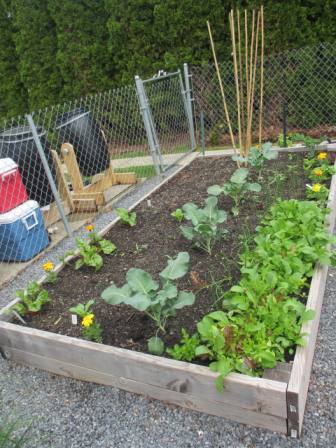(aka Fresh Picked Salad for One)
by Maria G.
A great deal of thought and planning takes place when I look over the selections in the seed catalog in November. I hope to choose interesting varieties of seed that do well in my NJ garden and taste great when prepared for the table.
Lettuce is an early crop which grows best in cool temperatures. You can either start your seeds in early spring and transplant into the garden beds for an early harvest… or, direct-seed them into your garden without the extra steps.
Starting Lettuce Seed Indoors
My newest seed experience included a single seed packet with a variety of many types of lettuce. I started the seed early (as the weather permitted), then transplanted my newly sprouted seedlings into the garden beds. Then I moved the rest to plastic pots to remain on the patio.
For the growing table, I propped up an old door in the basement and rigged a fluorescent light from a chain to provide the light needed to grow sturdy, healthy plants. Within a month, an exciting array of shapes and colors were growing in the pots, with colors ranging from light green to rosy red to brilliant mahogany. On April 11, 2013 I picked a leaf here and there, and served a crisp and sweet, single-serve salad for one!
Direct-Seeding Lettuce into Your Garden Beds
Use a hoe to break up clumps of dirt, and then a rake to smooth out the soil. Once you have worked a bed smooth, dampen the soil a bit. You can use an old yard stick to measure the spacing between plants – for lettuce, this can be anywhere from 6 to 10 inches depending on the quality of your soil and the depth of your beds (the better the quality and the deeper your garden beds, the less space you’ll need). I use a small piece of branch to poke my seed holes about a half-inch deep before dropping the seeds in. If you are a new gardener, you may also wish to put a small amount of horticultural vermiculite into each hole.
Once all your seed holes have been spaced and prepped, drop 2 seeds into each hole and then cover with ¼ inch of vermiculite. Keep the planted area gently watered. When the seedlings emerge, fertilize with fish emulsion to further strengthen the plants. Simply add 1 Tablespoon of the fish emulsion to your filled watering can, and then water with this solution once per week, in addition to your usual watering.
Baby Lettuce: matures in 25 days
Fully Mature Lettuce: matures in 35 to 68 days
Remember to check the seed name and the days to maturity when making selections for your garden. Of course, you’ll want to keep a variety of lettuce types readily available.
